All cameras are essentially the same in terms of their sensitivity to infrared radiation, as long as the internal blocking filter has been removed. The resulting image effect is therefore not dependent on the camera, but primarily on the type of infrared effect filter installed (as well as on the post-processing). Depending on which infrared filter is installed, you get a very distinct image look. In addition, some built-in filters can be combined with a screw-on filter to create a different image effect.
Infrared Filters - an Overview
To better understand the image effect of the individual filters, a comparison is useful. Of course the RAW files can also be downloaded for free to better understand the image effect and try editing in your own software. The download area can be found at the bottom of this page or in the profile of the individual filters.
We have compared the filters with different processing states. The right-hand column shows the photos with automatic white balance, which is usually "wrong". The image effect in the penultimate column can be achieved with a manual white balance in the camera. The first column shows the edited photo with correctly set white balance (in this case on the clouds). A channel swap is typical for IR images in order to achieve a blue sky. This image look is usually the desired image result for color IR images and can be seen in the 2nd column. In the middle is the black and white processing of the individual filter types. Click on the image to enlarge it!
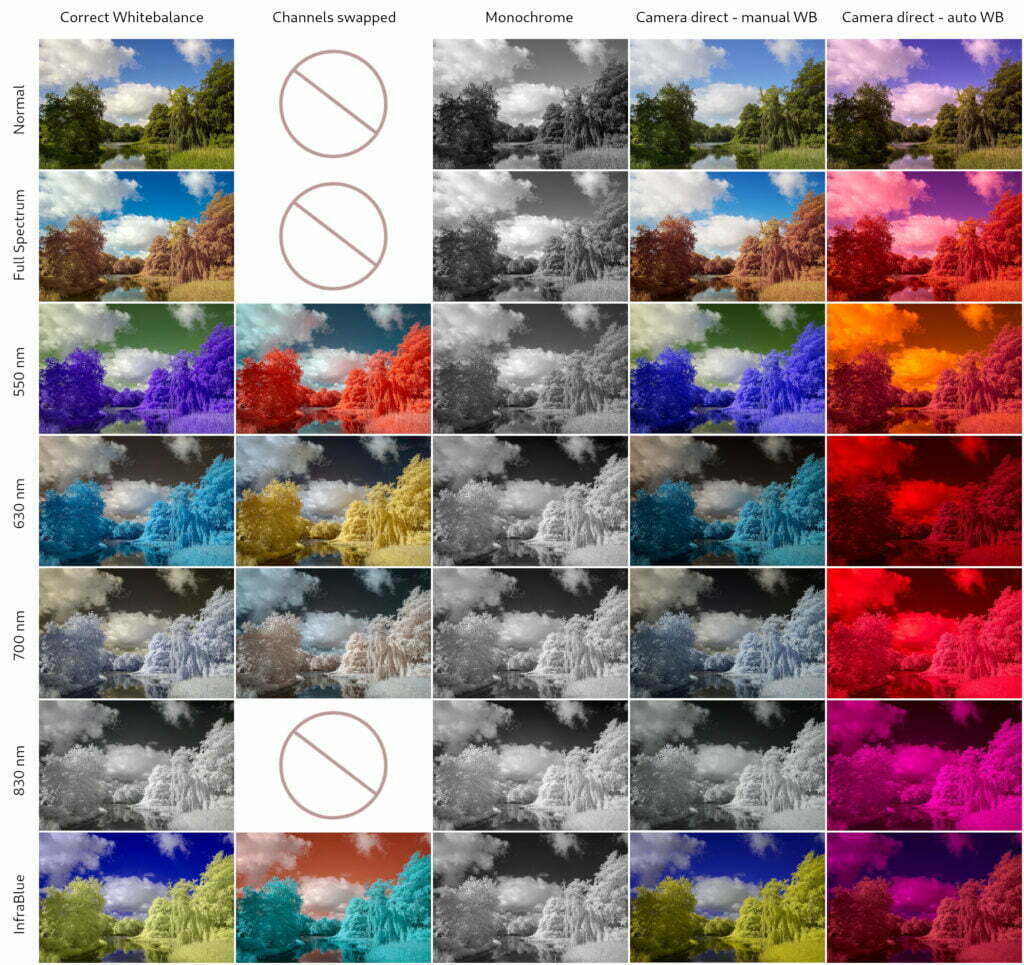
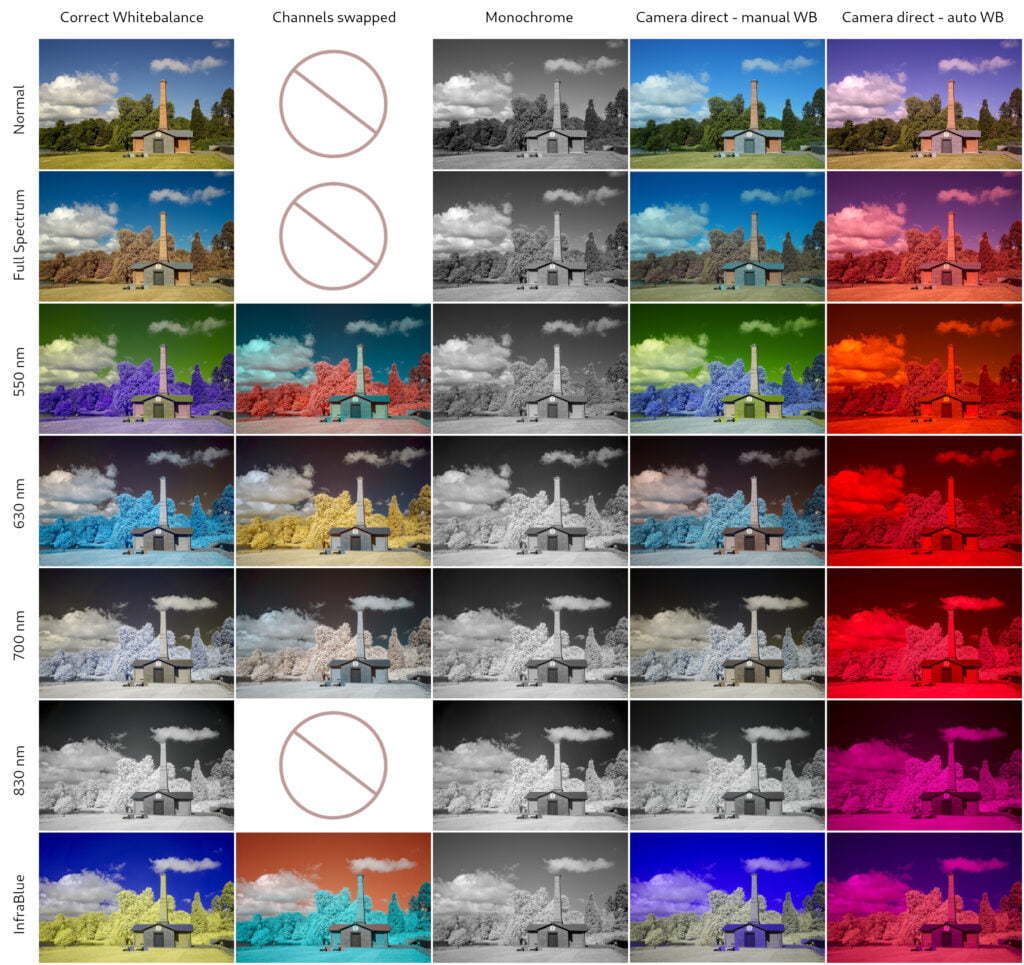
Infrared Effect Filter Profiles and Details
Each infrared filter creates its own look and therefore leads to a special image result. There is no one filter that can do everything. Each filter is designed for a specific image effect.For detailed information and description click on the button and jump directly to the filter profile.
In general: For black and white infrared photography stronger IR filters (700 nm and 830 nm) are recommended, but if color IR photography is the focus, the weaker filters (e.g. 630 nm and 550 nm) have a clear advantage.
Full Spectrum Filter
A full spectrum filter is not actually an effect filter but a technical option to open the sensor to the entire spectrum. It is a 280 nm long-pass filter that allows the entire spectrum from 280 nm to 1,200 nm to pass through to the sensor. This "clear glass" option can be combined with all filters, meaning that you can screw any filter in front of the lens and variably influence the image effect that is generated in the end with just one camera. In addition to infrared images, UV photos can also be taken or completely "normal" images can be shot in the visible range.
A full spectrum conversion not only provides the technical basis for using any possible infrared effect filter, it can also be used as a stand-alone solution to make the camera more sensitive. This can lead to lower ISO values and thus lower noise in astrophotography. For wide-angle nightscapes, however, this filter choice is not recommended. Light pollution from cities and villages leads to color shifts that are difficult to correct. For deep space photography, however, a full spectrum conversion is a good and flexible alternative to an astro filter.
Advantages of Full Spectrum
- All infrared or UV effect filters can be used as screw-in filters without restrictions
- Flexible and fast change of the image look
- With UV/IR cut filter, "normal" shots with the camera are also possible again
- Very high sensitivity (approx. + 1 EV)
Disadvantages of Full Spectrum
- An additional screw-on filter must usually be purchased, potentially in various sizes
- A filter must be screwed onto each lens
- Possible problems with focusing and light metering (ONLY with DSLR cameras)
A Full Spectrum Camera can be combined with following screw-on filters:
- 550 nm
- 630 nm
- 700 nm
- 830 nm
- InfraBlue
- Normal
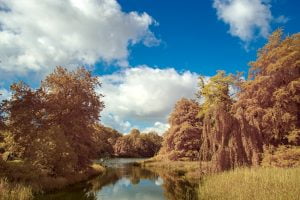



Download RAW Files: Motif 1 | Motif 2
550 nm Infrared Filter
The weakest infrared filter is a 550 nm long-pass filter, which allows the spectrum from 550 nm to the deep IR of 1,200 nm to pass through. This orange piece of glass is of little interest for black and white infrared photography, but offers the possibility of generating an image with a blue sky and red foliage. This comes very close to the analog infrared film "Kodak Aerochrome" and is an image effect that many infrared photographers strive for. Post-processing is somewhat more complex because a double channel swap has to be carried out (red-blue and green-blue). With the channel mixer and a little experimentation, many other image effects are possible. As the weakest infrared filter, it can also be combined with many other filters.
Advantages 550 nm Filter
- With post-processing, red leaves and blue sky are possible ("Kodak Aerochrome Look")
- Can be combined with all other long-pass filters as screw-on filters
- High sensitivity after conversion (approx. + 1/3 EV)
Disadvantages 550 nm Filter
- A relatively large amount of post-processing required
- Not suitable for B&W IR photography
- Extreme white balance is necessary, many cameras have problems with this (but the white balance can be set from the RAW file during post-processing)
A camera with a built-in 550 nm filter can be combined with the following screw-on filters:
- 630 nm
- 700 nm
- 830 nm






Download RAW Files: Motif 1 | Motif 2
630 nm Infrared Filter
The 630 nm filter allows light in the range from 630 nm to 1,200 nm to pass through. It is used primarily in color infrared photography. The red piece of glass can generate a blue sky in combination with golden foliage. Post-processing is slightly less involved than with the 550 nm filter, but a red-blue channel swap is still necessary to get a blue sky and golden foliage. The basic color saturation in the image is very high and you don't have to move the sliders too much to get a good image result. But also partially desaturated images (Colorkey) and black and white images can be created with this filter.
It does not provide the most intense black and white infrared image, but is still good for black and white images. In particular, anyone looking for more "shades of grey" in treetops than just a very bright white will also appreciate this filter for monochrome infrared images. For a stronger black and white infrared image effect, the 700 nm filter is recommended. A similar image impression, but without the need for channel swapping, is provided by the InfraBlue Filter.
Advantages 630 nm Filter
- With post processing yellow-golden foliage and blue sky is possible
- Can be combined with some long-pass screw filters
- Especially suitable for color IR imaging (high color saturation available)
- Black and white images are also possible
- Partial desaturation (Colorkey) is possible
- Good sensitivity after conversion (approx. -1/3 EV)
Disadvantages 630 nm Filter
- Color post-processing requires a channel swap to get a blue sky and yellow foliage
- Black and white images have slightly less contrast than with stronger filters, especially the sky is brighter
- Intense white balance is necessary, some cameras have problems here (but the white balance can be set during postprocessing from the RAW file)
A camera with a built-in 630 nm filter can be combined with the following screw-on filters:
- 700 nm
- 830 nm

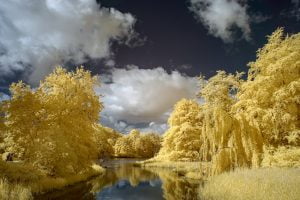
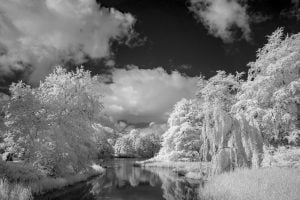



Download RAW Files: Motif 1 | Motif 2
700 nm Infrared Filter
A 700 nm filter allows light in the range from 700 to 1,200 nm to pass through. When you hold it in your hands, you practically have a black disk in front of your eyes. The 700 nm filter can be regarded as a "true" infrared filter because it no longer allows any significant parts of the visible light to pass through. It can be used to produce both color IR and black and white infrared images. It is the most commonly used filter and is always recommended for undecided "beginners" in infrared photography.
For black and white infrared photography, the filter offers a very high-contrast image with almost white foliage and a dark sky. Stronger IR filters provide slightly more intense image results, but at the expense of sensitivity. If the focus is to be more on color IR photography, the 630 nm or InfraBlue filter is a good alternative.
Advantages 700 nm Filter
- Especially suitable for black and white IR images
- Color IR images are also possible (with post-processing yellow-gold foliage and blue sky is an option)
- Partial desaturation (Colorkey) is possible
Disadvantages 700 nm Filter
- Sensitivity slightly reduced compared to a non-converted camera (approx. -2/3 EV)
- Low color saturation for color infrared images
- Channel swap is necessary to get a blue sky and yellow foliage
A camera with a built-in 700 nm filter can be combined with the following screw-on filters:
- 830 nm


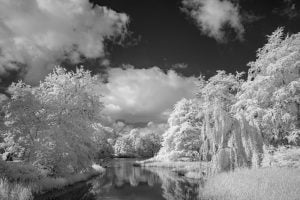



Download RAW Files: Motif 1 | Motif 2
830 nm Infrared Filter
Color images are no longer possible with the 830 nm filter; it only provides monochrome infrared images. The black and white result is only slightly more intense than with the 700 nm filter. However, this small advantage comes at the price of significantly lower sensitivity. The filter swallows approx. 2 f-stops of light, which is why it cannot be unreservedly recommended as the best black and white infrared filter. As a rule, the higher sensitivity of the 700 nm filter is worth more than the small gain in infrared contrast. With a 700 nm filter and a little post-processing, this gap can be closed very easily. This filter only makes sense if there is a technical necessity.
Advantages 830 nm Filter
- Provides a slightly more intense black and white IR image than the 700 nm filter
Disadvantages 830 nm Filter
- High loss of sensitivity (approx. -2 EV)
- Only SW infrared images are possible, no color IR
- Cannot be combined with any screw-on filter


Download RAW Files: Motif 1 | Motif 2
InfraBlue Filter
The InfraBlue filter is a multibandpass filter that greatly simplifies post-processing of the IR image. It delivers similar image results like the 630 nm filter, i.e. a blue sky and yellow foliage. However, the InfraBlue filter does not require any channel swapping: You can see the final image on the camera display. This is particularly useful if the camera is used for infrared filming.
Besides the simple possibility to create color IR images, the filter is also very good for monochrome IR images or Colorkey images. Due to the high saturation of the file, a channel mixer can be used for the black and white conversion, which offers a lot of control over the image result.
Advantages InfraBlue Filter
- Yellow foliage and blue sky with high color saturation
- The final image can be evaluated on the camera display
- Black and white recordings are possible (a lot of control via channel mixer)
- Partial desaturation (Colorkey) is possible
- Easy filming in infrared: No need to swap channels in video post-processing
Disadvantages InfraBlue Filter
- Human skin is rendered in yellow, similar to foliage
- Increased chromatic aberrations may become visible at high-contrast edges
- Screw-on filter can only be used on a full spectrum camera
- Sensitivity slightly reduced compared to a non-converted camera (approx. -2/3 EV)
A camera with a built-in InfraBlue filter can be combined with the following screw-on filters:
- 700 nm
- 830 nm




Download RAW Files: Motif 1 | Motif 2
Normal Filter (Hotmirror)
The name says it all. This filter is a UV/IR blocking filter and only allows visible light to reach the sensor. On a Full spectrum camera, such screw-in filters can be installed in order to be able to take "completely normal" pictures again. This means that just one camera can be used for both infrared and normal photography.
Advantages Normal Filter
- Can deliver "normal" photos in the visible range again with a full spectrum camera
Disadvantages Normal Filter
- Cannot be combined with any screw-on filters
- Sensitivity slightly reduced compared to a non-converted camera (approx. -1/2 EV)




Download RAW Files: Motif 1 | Motif 2
Free Infrared RAW files for Download
| Infrared Effect Filter | Motif 1 | Motif 2 |
|---|---|---|
| Full Spectrum Filter | Download | Download |
| 550 nm Infrared Filter | Download | Download |
| 630 nm Infrared Filter | Download | Download |
| 700 nm Infrared Filter | Download | Download |
| 830 nm Infrared Filter | Download | Download |
| InfraBlue Infrared Filter | Download | Download |
| Normal filter | Download | Download |
Filter knowledge - different types of infrared filters
Long pass infrared filter
Long pass infrared filters only allow light of a certain wavelength to pass through. A 700 nm filter, for example, allows light in the range from 700 nm to 1,200 nm to reach the sensor (even longer wavelength light arrives at the sensor but can not be detected by it). Shorter wavelengths below 700 nm (i.e. the range visible to humans) are blocked and do not reach the sensor.
From a wavelength of approx. 830 nm, only black and white infrared can be photographed. If you want to take color infrared pictures, at least a certain amount of short-wave light must also reach the sensor. As a rule of thumb, the weaker a filter is, the more suitable it is for color IR photography. On the other hand, weak infrared filters produce less intense black and white images. Even if you are only interested in black and white images, I recommend the 700 nm filter for black and white infrared photos (more in the profile).
Multispectral Infrared Filters
Multispectral infrared filters allow light from different parts of the spectrum to pass through. The sensor sees a mixture of infrared light and visible light in different ratios. The transmission curves of these filters are relatively complex, but the image look they generate in camera simplifies post-processing enormously. These filters are mainly used in color infrared photography, but black and white infrared photography is also possible. With multispectral filters, you get a blue sky already in the camera (without channel swapping). These filters are also more suitable for filming in the infrared range, because post-processing is reduced to a minimum.
